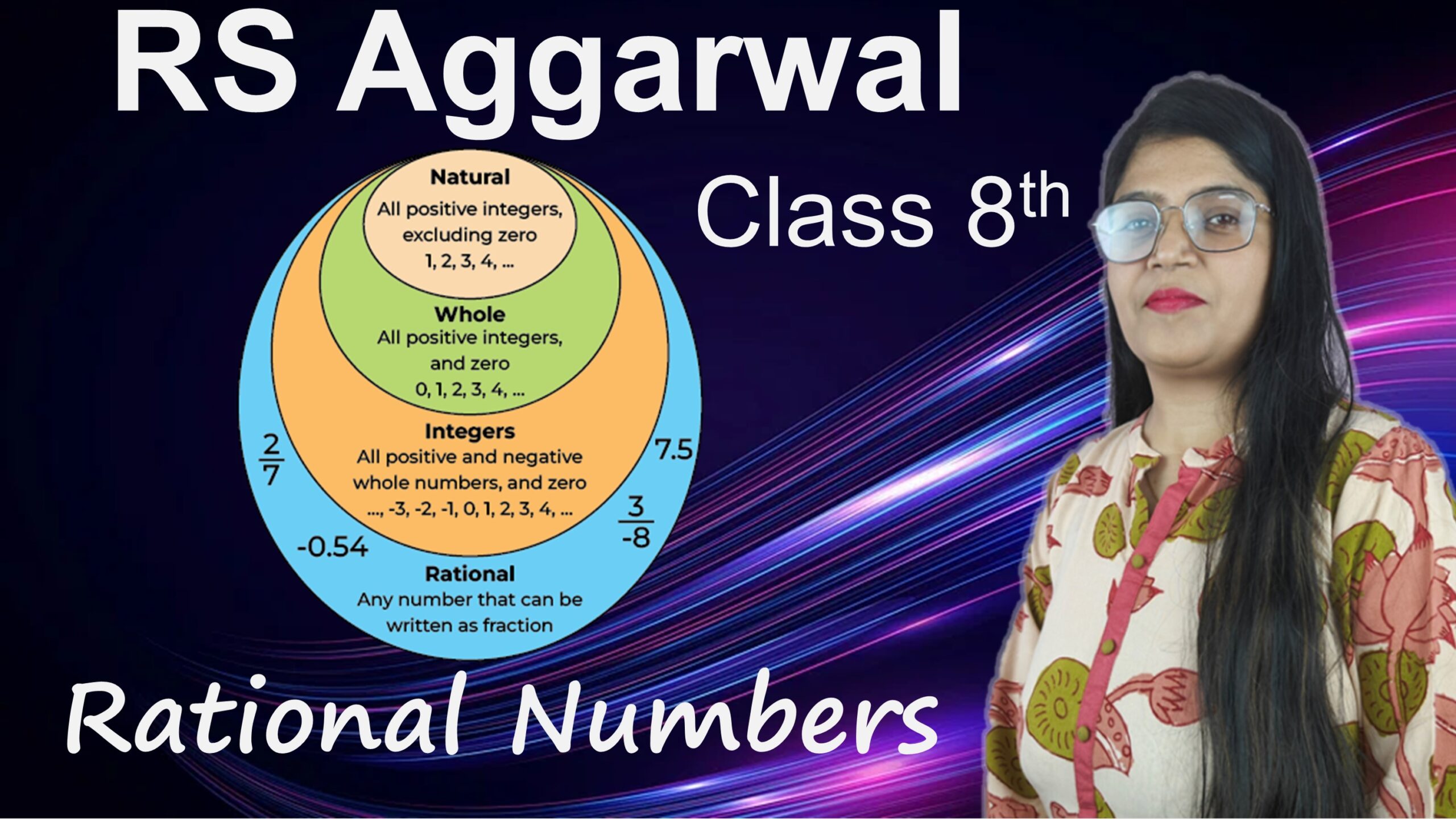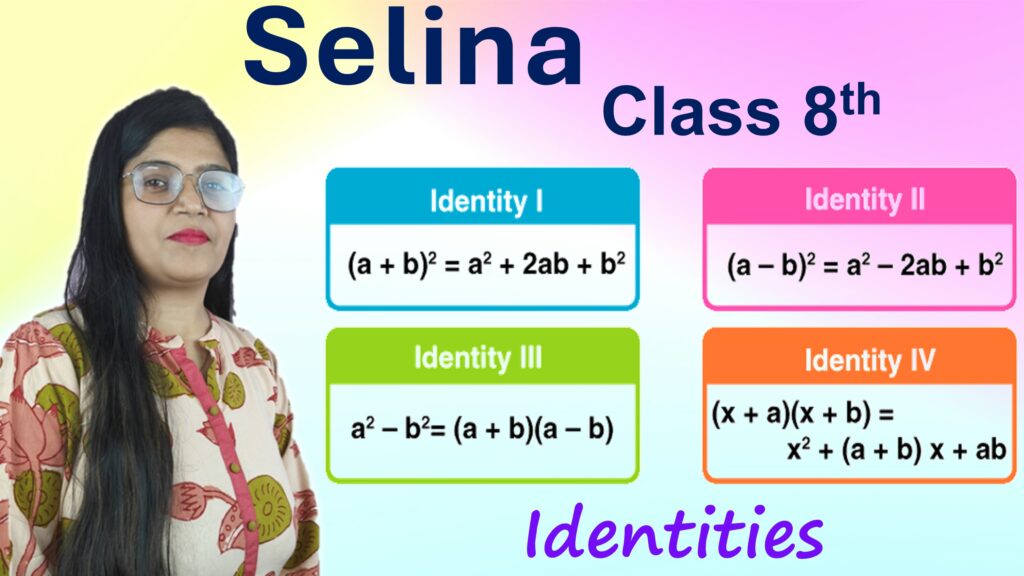Exercise: 1-C
Q1: Find the products:
i. \(\frac{4}{9}\times\frac{7}{12}\)
Step 1: Multiply numerators → \( 4 \times 7 = 28 \)
Step 2: Multiply denominators → \( 9 \times 12 = 108 \)
So, \( \frac{4}{9} \times \frac{7}{12} = \frac{28}{108} \)
Step 3: Simplify → Divide numerator and denominator by 4:
\( \frac{28 \div 4}{108 \div 4} = \frac{7}{27} \)
Answer: \( \frac{7}{27} \)
ii. \(-9\times\frac{7}{18}\)
Write -9 as a fraction → \( \frac{-9}{1} \)
Now multiply: \( \frac{-9}{1} \times \frac{7}{18} = \frac{-63}{18} \)
Simplify by dividing both by 9: \( \frac{-63 \div 9}{18 \div 9} = \frac{-7}{2} \)
Answer: \( \frac{-7}{2} \)
iii. \(\frac{-3}{16}\times\frac{8}{-15}\)
Multiply numerators: \( -3 \times 8 = -24 \)
Multiply denominators: \( 16 \times -15 = -240 \)
So, \( \frac{-3}{16} \times \frac{8}{-15} = \frac{-24}{-240} \)
Negative ÷ Negative = Positive → \( \frac{24}{240} \)
Simplify: \( \frac{1}{10} \)
Answer: \( \frac{1}{10} \)
iv. \(\frac{6}{7}\times\frac{-21}{12}\)
Multiply numerators: \( 6 \times (-21) = -126 \)
Multiply denominators: \( 7 \times 12 = 84 \)
So, \( \frac{6}{7} \times \frac{-21}{12} = \frac{-126}{84} \)
Simplify: Divide by 6 → \( \frac{-21}{14} \), then by 7 → \( \frac{-3}{2} \)
Answer: \( \frac{-3}{2} \)
v. \(\frac{5}{-18}\times-\frac{9}{20}\)
Rewriting: \( \frac{5}{-18} \times \frac{-9}{20} \)
Multiply numerators: \( 5 \times -9 = -45 \)
Multiply denominators: \( -18 \times 20 = -360 \)
So, \( \frac{-45}{-360} = \frac{45}{360} \)
Simplify: Divide by 45 → \( \frac{1}{8} \)
Answer: \( \frac{1}{8} \)
vi. \(\frac{-13}{15}\times\frac{-25}{26}\)
Multiply numerators: \( -13 \times -25 = 325 \)
Multiply denominators: \( 15 \times 26 = 390 \)
So, \( \frac{-13}{15} \times \frac{-25}{26} = \frac{325}{390} \)
Simplify: Divide by 13 → \( \frac{25}{30} \), then by 5 → \( \frac{5}{6} \)
Answer: \( \frac{5}{6} \)
vii. \(\frac{7}{24}\times\left(-48\right)\)
Write -48 as \( \frac{-48}{1} \)
Multiply: \( \frac{7}{24} \times \frac{-48}{1} = \frac{-336}{24} \)
Simplify: \( \frac{-336}{24} = -14 \)
Answer: \( -14 \)
viii. \(\frac{-13}{5}\times\left(-10\right)\)
Write -10 as \( \frac{-10}{1} \)
Multiply: \( \frac{-13}{5} \times \frac{-10}{1} = \frac{130}{5} \)
Simplify: \( \frac{130}{5} = 26 \)
Answer: \( 26 \)
Q2: Find the multiplicative inverse (or reciprocal) of:
i. \(\frac{-17}{12}\)
Reciprocal of \( \frac{a}{b} \) is \( \frac{b}{a} \)
So, reciprocal of \( \frac{-17}{12} \) is \( \frac{12}{-17} \)
Answer: \( \frac{-12}{17} \)
ii. \(-16\)
Write -16 as \( \frac{-16}{1} \)
Now take reciprocal → \( \frac{1}{-16} \)
Answer: \( \frac{-1}{16} \)
iii. \(\frac{0}{2}\)
This is just 0.
Zero has no multiplicative inverse because no number multiplied by 0 gives 1.
Answer: Not defined
iv. \(\frac{-3}{-5}\)
Negative divided by negative is positive → \( \frac{-3}{-5} = \frac{3}{5} \)
Reciprocal of \( \frac{3}{5} \) is \( \frac{5}{3} \)
Answer: \( \frac{5}{3} \)
v. \(\frac{2}{-5}\)
Reciprocal of \( \frac{2}{-5} \) is \( \frac{-5}{2} \)
Answer: \( \frac{-5}{2} \)
Q3: Find the quotient:
i. \(\frac{17}{8}\div\frac{51}{4}\)
Step 1: Division means multiply by reciprocal:
\( \frac{17}{8} \div \frac{51}{4} = \frac{17}{8} \times \frac{4}{51} \)
Step 2: Multiply the numerators → \( 17 \times 4 = 68 \)
Step 3: Multiply the denominators → \( 8 \times 51 = 408 \)
So, \( \frac{17}{8} \div \frac{51}{4} = \frac{68}{408} \)
Simplify → Divide both by 68: \( \frac{1}{6} \)
Answer: \( \frac{1}{6} \)
ii. \(\frac{-16}{35}\div\frac{15}{14}\)
Step 1: Multiply by reciprocal:
\( \frac{-16}{35} \div \frac{15}{14} = \frac{-16}{35} \times \frac{14}{15} \)
Step 2: Multiply numerators → \( -16 \times 14 = -224 \)
Multiply denominators → \( 35 \times 15 = 525 \)
So, \( \frac{-224}{525} \)
Simplify → Divide both by 7: \( \frac{-32}{75} \)
Answer: \( \frac{-32}{75} \)
iii. \(\frac{-12}{7}\div\left(-16\right)\)
Write -16 as a fraction: \( \frac{-16}{1} \)
Now divide: \( \frac{-12}{7} \div \frac{-16}{1} = \frac{-12}{7} \times \frac{1}{-16} \)
Negative × Negative = Positive → \( \frac{12}{112} \)
Simplify: \( \frac{3}{28} \)
Answer: \( \frac{3}{28} \)
iv. \(-9\div\left(\frac{-5}{18}\right)\)
Write -9 as \( \frac{-9}{1} \)
Now divide: \( \frac{-9}{1} \div \frac{-5}{18} = \frac{-9}{1} \times \frac{18}{-5} \)
Negative × Negative = Positive → \( \frac{162}{5} \)
Answer: \( \frac{162}{5} \)
Q4: Name the property of multiplication illustrated by each of the following statements:
i. \(\frac{-8}{9}\times\frac{-13}{7}=\frac{-13}{7}\times\frac{-8}{9}\)
Changing the order of multiplication doesn’t change the result.
Property: Commutative Property of Multiplication
ii. \(\left(\frac{-3}{4}\times\frac{5}{7}\right)\times\frac{-9}{11}=\frac{-3}{4}\times\left(\frac{5}{7}\times\frac{-9}{11}\right)\)
Grouping changes but the result remains same.
Property: Associative Property of Multiplication
iii. \(\frac{-2}{3}\times\left(\frac{-5}{6}+\frac{7}{8}\right)=\left(\frac{-2}{3}\times\frac{-5}{6}\right)+\left(\frac{-2}{3}\times\frac{7}{8}\right)\)
Multiplying a number over a sum equals sum of individual products.
Property: Distributive Property of Multiplication over Addition
iv. \(\frac{-18}{7}\times1=1\times\frac{-18}{7}=\frac{-18}{7}\)
Any number multiplied by 1 gives the same number.
Property: Multiplicative Identity
v. \(\frac{-13}{17}\times\frac{17}{-13}=\frac{17}{-13}\times\frac{-13}{17}=1\)
Product of a number and its reciprocal is 1.
Property: Multiplicative Inverse
vi. \(\frac{-9}{7}\times0=0\)
Any number multiplied by zero is always zero.
Property: Multiplication by Zero
Q5: Verify whether the given statement is true or false:
i. \(\frac{-8}{9}\div\frac{-4}{3}=\frac{-4}{3}\div\frac{-8}{9}\)
Let’s solve both sides separately:
LHS: \( \frac{-8}{9} \div \frac{-4}{3} = \frac{-8}{9} \times \frac{3}{-4} = \frac{24}{36} = \frac{2}{3} \)
RHS: \( \frac{-4}{3} \div \frac{-8}{9} = \frac{-4}{3} \times \frac{9}{-8} = \frac{36}{24} = \frac{3}{2} \)
So, \( \frac{2}{3} \ne \frac{3}{2} \)
Answer: False
ii. \(\frac{-7}{24}\div\frac{3}{16}=\frac{3}{-16}\div\frac{-7}{24}\)
LHS: \( \frac{-7}{24} \div \frac{3}{16} = \frac{-7}{24} \times \frac{16}{3} = \frac{-112}{72} = \frac{-28}{18} = \frac{-14}{9} \)
RHS: \( \frac{3}{-16} \div \frac{-7}{24} = \frac{-3}{16} \times \frac{24}{-7} = \frac{72}{112} = \frac{18}{28} = \frac{9}{14} \)
So, \( \frac{-14}{9} \ne \frac{9}{14} \)
Answer: False
iii. \(\left(\frac{-3}{5}\div\frac{-12}{35}\right)\div\frac{1}{4}=\frac{-3}{5}\div\left(\frac{-12}{35}\div\frac{1}{4}\right)\)
Solve LHS first:
Step 1: \( \frac{-3}{5} \div \frac{-12}{35} = \frac{-3}{5} \times \frac{35}{-12} = \frac{105}{60} = \frac{7}{4} \)
Now divide by \( \frac{1}{4} \):
\( \frac{7}{4} \div \frac{1}{4} = \frac{7}{4} \times \frac{4}{1} = 7 \)
Now solve RHS:
Step 1: \( \frac{-12}{35} \div \frac{1}{4} = \frac{-12}{35} \times 4 = \frac{-48}{35} \)
Now divide: \( \frac{-3}{5} \div \frac{-48}{35} = \frac{-3}{5} \times \frac{35}{-48} = \frac{105}{240} = \frac{7}{16} \)
LHS = 7, RHS = \( \frac{7}{16} \)
Answer: False
Q6: Fill in the blanks:
i. ___________ is the rational number that does not have a multiplicative inverse.
Any number that has no reciprocal must be such that it cannot be multiplied by any number to get 1.
Since \( 0 \times \text{anything} = 0 \), and not 1 —
Answer: 0
ii. ___________ and ___________ are the rational numbers which are equal to their own reciprocals.
If \( x = \frac{1}{x} \), then multiplying both sides by x gives \( x^2 = 1 \Rightarrow x = \pm1 \)
Answer: 1 and -1
iii. The product of a rational number and its reciprocal is ___________.
By definition, \( a \times \frac{1}{a} = 1 \) (when \( a \ne 0 \))
Answer: 1
iv. The reciprocal of a positive rational number is ___________.
Reciprocal means flip the numerator and denominator → remains positive.
Answer: Positive
v. The reciprocal of a negative rational number is ___________.
Reciprocal of negative is also negative (sign remains).
Answer: Negative
vi. ___________ is not the reciprocal of any number.
0 is never a result of a reciprocal. There’s no number whose reciprocal is 0.
Answer: 0
vii. The multiplicative inverse of a rational number \(\frac{1}{a}\), a ≠ 0, is ___________.
Flip it: \( \frac{1}{a} \Rightarrow a \)
Answer: a
QQ7: The product of two rational numbers is \(-7\). If one of the numbers is \(\frac{-8}{11}\) , find the other.
Let the other number be \( x \).
According to the question:
\( \frac{-8}{11} \times x = -7 \)
To find \( x \), divide both sides by \( \frac{-8}{11} \):
\[
x = \frac{-7}{\frac{-8}{11}} = -7 \div \frac{-8}{11}
\]Now apply reciprocal and multiply:
\[
x = -7 \times \frac{11}{-8} = \frac{-77}{-8} \\
x = \frac{77}{8}
\]Answer: \( \frac{77}{8} \) or \(9\frac{5}{8}\)
Q8: The rational numbers is \(\frac{-16}{9}\). If one of the numbers is \(\frac{-4}{3}\), find the other.
Let the other number be \( x \).
\[
\frac{-4}{3} \times x = \frac{-16}{9}
\]To find \( x \), divide both sides by \( \frac{-4}{3} \):
\[
x = \frac{-16}{9} \div \frac{-4}{3} = \frac{-16}{9} \times \frac{3}{-4}
\]Now multiply:
\[
x = \frac{48}{36} = \frac{4}{3}
\]Answer: \( \frac{4}{3} \)
Q9: By what rational number must \(\frac{1}{26}\) be divided to get \(\frac{-8}{39}\)?
Let the required rational number be \( x \).
So, according to the question:
\[
\frac{1}{26} \div x = \frac{-8}{39}
\]Now, multiply both sides by \( x \):
\[
\frac{1}{26} = \frac{-8}{39} \times x
\]To isolate \( x \), divide both sides by \( \frac{-8}{39} \):
\[
x = \frac{1}{26} \div \frac{-8}{39} = \frac{1}{26} \times \frac{39}{-8}
\]Now multiply:
\[
x = \frac{39}{-208} = \frac{-39}{208}
\]
Simplify → Divide both by 13: \( \frac{-3}{16} \)
Answer: \( \frac{-3}{16} \)
Q10: Divide the sum of \(\frac{13}{5}\) and \(\frac{-12}{7}\) by the product of \(\frac{-31}{7}\) and \(\frac{1}{-2}\).
Step 1: Find the sum of \( \frac{13}{5} \) and \( \frac{-12}{7} \)
Take LCM of 5 and 7 = 35
\[
\frac{13}{5} = \frac{91}{35}, \quad \frac{-12}{7} = \frac{-60}{35} \\
\text{Sum} = \frac{91 – 60}{35} = \frac{31}{35}
\]Step 2: Find the product of \( \frac{-31}{7} \) and \( \frac{1}{-2} \)
\[
\frac{-31}{7} \times \frac{1}{-2} = \frac{31}{14}
\]
Step 3: Divide the sum by the product
\[
\frac{31}{35} \div \frac{31}{14} = \frac{31}{35} \times \frac{14}{31}
\]
Cancel 31 from numerator and denominator:
\[
= \frac{14}{35} = \frac{2}{5}
\]Answer: \( \frac{2}{5} \)
Q11: Divide the sum of \(\frac{65}{12}\) and \(\frac{8}{3}\) by their difference.
Step 1: Convert \( \frac{8}{3} \) to same denominator as \( \frac{65}{12} \)
\[
\frac{8}{3} = \frac{32}{12}
\]
Step 2: Sum of the two numbers
\[
\frac{65}{12} + \frac{32}{12} = \frac{97}{12}
\]Step 3: Difference of the two numbers
\[
\frac{65}{12} – \frac{32}{12} = \frac{33}{12}
\]
Simplify difference:
\[
\frac{33}{12} = \frac{11}{4}
\]Step 4: Divide the sum by the difference
\[
\frac{97}{12} \div \frac{11}{4} = \frac{97}{12} \times \frac{4}{11} \\
= \frac{388}{132}
\]
Simplify by dividing numerator and denominator by 4:
\[
= \frac{97}{33}
\]Answer: \( \frac{97}{33} \)
Q12: Find the of \(3\frac{2}{5}\) metres of cloth at ₹ \(63\frac{3}{4}\) per metre.
Step 1: Convert to improper fractions
\[
3\frac{2}{5} = \frac{17}{5}, \quad 63\frac{3}{4} = \frac{255}{4}
\]Step 2: Multiply the two
\[
\frac{17}{5} \times \frac{255}{4} = \frac{4335}{20}
\]Step 3: Convert to mixed number
\[
\frac{4335}{20} = 216\frac{15}{20} = 216\frac{3}{4}
\]Answer: ₹ \( 216\frac{3}{4} \)
Q13: Find the area of a part which is \(36\frac{3}{5}\) m long and \(16\frac{2}{5}\) m broad.
Step 1: Convert to improper fractions
\[
36\frac{3}{5} = \frac{183}{5}, \quad 16\frac{2}{5} = \frac{82}{5}
\]Step 2: Multiply to find area
\[
\text{Area} = \frac{183}{5} \times \frac{82}{5} = \frac{15006}{25}
\]Step 3: Convert to mixed number
\[
\frac{15006}{25} = 600\frac{6}{25}
\]Answer: \( 600\frac{6}{25} \, \text{m}^2 \)
Q14: Find the area of a square plot of land whose each side measures \(8\frac{1}{2}\) metres.
Step 1: Convert to improper fraction
\[
8\frac{1}{2} = \frac{17}{2}
\]Step 2: Use the formula for area of square
\[
\text{Area} = \left( \frac{17}{2} \right)^2 = \frac{289}{4}
\]Step 3: Convert to mixed number
\[
\frac{289}{4} = 72\frac{1}{4}
\]Answer: \( 72\frac{1}{4} \, \text{m}^2 \)
Q15: A cord of length \(71\frac{1}{2}\) m has been cut into 26 pieces of equal length. What is the length of each piece?
Step 1: Convert to improper fraction
\[
71\frac{1}{2} = \frac{143}{2}
\]Step 2: Divide by 26
\[
\text{Length of each piece} = \frac{143}{2} \div 26 = \frac{143}{2} \times \frac{1}{26} \\
= \frac{143}{52}
\]
Simplify → Divide both by 13: \( \frac{11}{4} \)
Step 3: Convert to mixed number
\[
\frac{11}{4} = 2\frac{3}{4}
\]Answer: \( 2\frac{3}{4} \, \text{m} \)
Q16: The area of a room is \(65\frac{1}{4}\) sq. metres. If its breadth is \(5\frac{1}{16}\) metres, what is its length?
Step 1: Convert both to improper fractions
\[
65\frac{1}{4} = \frac{261}{4}, \quad 5\frac{1}{16} = \frac{81}{16}
\]Step 2: Use formula: Length = Area ÷ Breadth
\[
\text{Length} = \frac{261}{4} \div \frac{81}{16} = \frac{261}{4} \times \frac{16}{81} \\
= \frac{4176}{324}
\]
Simplify:
\[
= \frac{58}{4.5} = \frac{232}{18} = \frac{116}{9}
\]
Convert to mixed number:
\[
= 12\frac{8}{9}
\]Answer: \( 12\frac{8}{9} \, \text{metres} \)







Leave a Comment